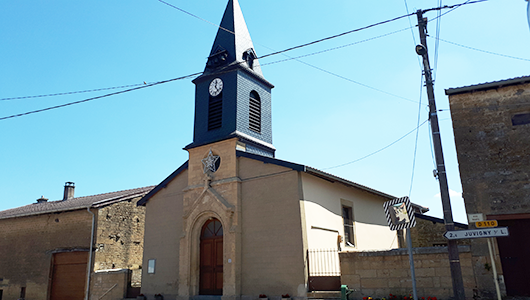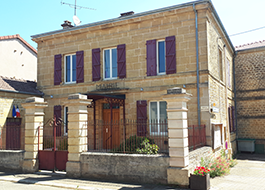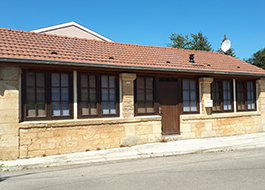Han-lès-Juvigny
Durée visite : 15 minutes
Moyen : Pédestre
Au haut Moyen Âge, un ancêtre des puissants comtes des Flandres possédait le village. Sans église ni cimetière, c’est un chapelain de l’abbaye de Juvigny qui venait administrer les sacrements. En 1791, Han obtient sa propre municipalité. Au XIXe siècle, deux carrières de pierre de taille de dureté moyenne assurent sa prospérité. De 1914 à 1939, un train relie Montmédy à Commercy via Han. Le Tacot peut attendre 40km/heure.
In the early Middle Ages, an ancestor of the powerful Counts of Flanders owned the village. Without church or cemetery, it was a chaplain from the abbey of Juvigny who came to administer the sacraments. In 1791, Han obtained his own municipality. In the 19th century, two medium-hard freestone quarries ensured its prosperity. From 1914 to 1939, a train connects Montmédy to Commercy via Han. Le Tacot can wait 40km / hour.
Im frühen Mittelalter besaß ein Vorfahr der mächtigen Grafen von Flandern das Dorf. Ohne Kirche oder Friedhof war es ein Kaplan aus der Abtei von Juvigny, der kam, um die Sakramente zu verwalten. Im Jahr 1791 erhielt Han seine eigene Gemeinde. Im 19. Jahrhundert sorgten zwei mittelharte Steinbrüche für Wohlstand. Von 1914 bis 1939 verbindet ein Zug Montmédy über Han mit Commercy. Le Tacot kann 40 km / h warten.
Les points de visites
.
L’église Saint-Jean-L’Evangéliste date du XVIIIe siècle. On remarque le carillon accroché à la flèche. Quatre petites cloches tintent toutes les demi-heures. Un oculus perce le mur de l’édifice. Le Saint Sacrement était placé dans un tabernacle mural aujourd’hui disparu. Il pouvait être adoré par les fidèles depuis le cimetière, et veillait également sur les morts.
On attribue à l’apôtre Jean de nombreux miracles. Afin de prouver aux Éphésiens la supériorité du christianisme sur le culte des idoles, Jean, sommé de boire une coupe de poison, en avale le contenu et n’en ressent rien, tandis que les deux goûteurs, désignés pour tester ce poison, s’écroulent foudroyés. Ils seront ensuite ressuscités par le saint, décidément très fair-play. Ne pas le confondre avec saint Jean-Baptiste.
The Saint-Jean-L’Evangéliste church dates from the 18th century. We notice the chime attached to the arrow. Four small bells ring every half hour. An oculus pierces the wall of the building. The Blessed Sacrament was placed in a wall tabernacle which has now disappeared. He could be worshiped by the faithful from the cemetery, and also watched over the dead.
The apostle John is credited with many miracles. In order to prove to the Ephesians the superiority of Christianity over idol worship, John, summoned to drink a cup of poison, swallows the contents and feels nothing of it, while the two tasters, appointed to test this poison, collapse struck by lightning. They will then be resurrected by the saint, decidedly very fair play. Not to be confused with St. John the Baptist.
Die Kirche Saint-Jean-L’Evangéliste stammt aus dem 18. Jahrhundert. Wir bemerken das Glockenspiel am Pfeil. Jede halbe Stunde läuten vier Glöckchen. Ein Okulus durchbohrt die Wand des Gebäudes. Das Allerheiligste Sakrament wurde in eine Mauer gelegt, die jetzt verschwunden ist. Er konnte von den Gläubigen vom Friedhof verehrt werden und auch über die Toten wachen.
Dem Apostel Johannes werden viele Wunder zugeschrieben. Um den Ephesern die Überlegenheit des Christentums über die Götzenanbetung zu beweisen, schluckt Johannes, der gerufen wird, um einen Becher Gift zu trinken, den Inhalt und fühlt nichts davon, während die beiden Verkoster, die dazu bestimmt waren, dieses Gift zu testen, vom Blitz getroffen zusammenbrechen. Sie werden dann vom Heiligen auferweckt, ausgesprochen sehr fair. Nicht zu verwechseln mit Johannes dem Täufer.
.
.
Ce très joli édifice a été bâti avec les pierres issues des carrières avoisinantes. Leur utilisation était essentiellement locale. Un toit de tuiles en pavillon recouvre la mairie. C’est la Révolution qui dota Han de son premier maire. Des portraits des présidents de la Troisième République sont conservés à l’intérieur.
This very pretty building was built with stones from neighboring quarries. Their use was mainly local. A pavilion tiled roof covers the town hall. It was the Revolution that gave Han its first mayor. Portraits of the presidents of the Third Republic are kept inside.
Dieses sehr hübsche Gebäude wurde mit Steinen aus benachbarten Steinbrüchen gebaut. Ihre Verwendung war hauptsächlich lokal. Ein Ziegeldach mit Pavillon bedeckt das Rathaus. Es war die Revolution, die Han ihren ersten Bürgermeister gab. Porträts der Präsidenten der Dritten Republik werden im Inneren aufbewahrt.
.
Le lavoir était lui aussi en pierres locales. D’où son aspect imposant. En France, les épidémies de choléra, de variole et de typhoïde incitent le Parlement à voter la loi du 3 février 1851. Elle accorde un crédit pour financer à hauteur de 30 % la construction des lavoirs couverts. Elle prévoit que c’est au lavoir commun que la laveuse trouvera une distribution d’eau chaude et d’eau froide, des appareils de séchage qui lui permettent une économie de temps, et qui lui évite d’effectuer le blanchissage dans l’habitation. Les travaux étaient mis en adjudication sur rabais à la chandelle.La vente à la chandelle est une forme d’adjudication particulière, puisqu’elle consiste à enchérir tant que deux bougies sont allumées. Les enchères cessent dès que les deux chandelles ont atteint leur terme.
The washhouse was also in local stones. Hence its imposing appearance. In France, the epidemics of cholera, smallpox and typhoid prompted Parliament to vote the law of February 3, 1851. It granted a loan to finance up to 30% of the construction of covered washhouses. She foresees that it is in the common washhouse that the washer will find a distribution of hot and cold water, drying devices which save her time, and which saves her from doing laundry in the home. . The works were auctioned off by candlelight discounts. The candlelight sale is a particular form of auction, since it consists of bidding while two candles are lit. The auction ceases as soon as the two candles have reached their end.
Das Waschhaus war ebenfalls aus lokalen Steinen. Daher sein imposantes Aussehen. In Frankreich veranlassten die Epidemien von Cholera, Pocken und Typhus das Parlament, das Gesetz vom 3. Februar 1851 zu verabschieden. Es gewährte ein Darlehen zur Finanzierung von bis zu 30% des Baus überdachter Waschhäuser. Sie sieht voraus, dass die Waschmaschine im gemeinsamen Waschhaus eine Verteilung von heißem und kaltem Wasser findet, Trocknungsvorrichtungen, die ihr Zeit sparen und sie davon abhalten, zu Hause Wäsche zu waschen. . Die Werke wurden durch Kerzenlichtrabatte versteigert. Kerzenlichtverkäufe sind eine besondere Form der Auktion, da sie aus Geboten bestehen, während zwei Kerzen angezündet werden. Die Auktion endet, sobald die beiden Kerzen ihr Ende erreicht haben.








